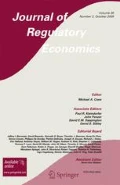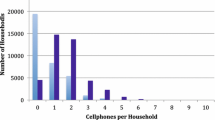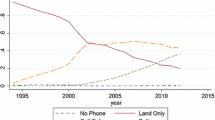Abstract
We study substitution from fixed-line to mobile voice access, and the role of various complementarities that may slow down this process. We use survey data of 160,363 households from 27 EU countries during 2005–2011. We estimate a discrete choice model where households may choose one or both voice technologies, possibly in combination with internet access. We obtain the following main findings. First, there is significant fixed-to-mobile substitution, especially in recent years: without mobile telephony, fixed-line penetration would have been 14.1 % higher at the end of 2011. But there is substantial heterogeneity across households and EU regions, with a stronger substitution in Central and Eastern European countries. Second, the decline in fixed telephony has been slowed down because of a significant complementarity between the fixed-line and mobile connections offered by the fixed-line incumbent operator. This gives the incumbent a possibility to protect its position in the fixed-line market, raising market share by 2.7 %, and to leverage it into the mobile market, raising market share by 5.4 % points. Third, the decline in fixed telephony has also been slowed down because of the complementarity with broadband internet: the introduction of DSL avoided an additional decline in fixed-line penetration of 8.7 % points at the end of 2011. The emergence of fixed broadband has thus been the main source through which incumbents maintain their strong position in the fixed-line network.

Similar content being viewed by others
Notes
For instance, Gruber and Verboven (2001) estimate a logistic diffusion model for mobile subscriptions in the EU and find that the penetration rate of fixed telephony has a negative influence on the diffusion of mobiles. On the other hand, Gruber (2001) uses a similar approach for the Central and Eastern European countries and suggests that mobile and fixed-line services may be complements. In another paper, Hamilton (2003) uses data for African countries finds that mobile and fixed-line subscriptions may be both complements and substitutes at different stages of market development. In the early stage of diffusion, mobile services may complement fixed-line telephones but the substitution effect takes over once mobile usage becomes more widespread.
Gentzkow (2007) also reports estimating a model specification in which the substitution parameter \(\Gamma \) varies with observable consumer characteristics.
There are two 2011 surveys. The first one was conducted in February–March 2011 and the second one was conducted in December 2011. The results of the first survey should not be much different if it was conducted at the end of 2010 instead. We consider therefore that it is equivalent to 2010 survey for consistency with other surveys which were conducted at the end of each year.
The surveys used in the analysis are: (i) Eurobarometer 64.4: Mental Well-Being, Telecommunications, Harmful internet Content, and Farm Animal Welfare, December 2005–January 2006; (ii) Eurobarometer 66.3: Social Reality, E-Communications, Commin Agricultural Policy, Discrimination and the Media, and Medical Research, November–December 2006; (iii) Eurobarometer 68.2: European Union Policy and Decision Making, Corruption, Civil Justice, E-Communications, Agriculture, and Environmental Protection, November–December 2007; (iv) Eurobarometer 72.5: E-Communications, Agriculture, Geographical and Labor Market Mobility, and Knowledge of Antibiotic Use, November–December 2009; (v) Eurobarometer 75.1: Energy in the European Union, Citizens’ Rights, E-Communications, the Internal Market, and Carbon Dioxide Capture and Storage, February–March 2011; (vi) Special Eurobarometer 381: E-communications Household Survey, December 2011.
We have combined the Teligen pricing data with the Eurobarometer survey data. Teligen data for years 200-2010 was collected in September, which is a few months earlier than the Eurobarometer data, which was usually collected at the end of the year. We assume that Eurobarometer data with fieldwork in: December 2005–January 2006 relates to 2005 Teligen data; Novembe-December 2006 relates to 2006; November 2007–January 2008 relates to 2007; November–December 2009 relates to 2009; February–March 2011 relates to 2010 and December 2011 also relates to 2010 due to lack of 2011 price information.
The prices for mobile services in years 2005–2010 decreased on average by 33 % with large differences across countries. The average change in prices between 2009 and 2010 is 0 %. Therefore, it seems reasonable to assume that price in 2011 remained the same as in 2010. Using prices imputed in a different way should have only a marginal impact on the estimates.
The usage of fixed-line and mobile telephones may obviously change when both services are used together.
Grzybowski (2014) uses the aggregate data from the Eurobarometer reports published by the European Commission to analyze fixed-to-mobile substitution. He reports that the share of ‘fixed \(+\) mobile’ households is positively correlated with percentage of households having internet access and negatively correlated with the share of households having cable modem.
We can also consider an alternative model specification, in which consumers choose between prepaid and postpaid mobile services. However, such analysis would be limited to years 2008, 2010 and 2011 only, for which we have prices for both prepaid and postpaid.
Gentzkow (2007) shows how prices for each separate alternative can identify complementarity or substitutability from unobserved correlation, so this applies for the case of two separate alternatives (here: fixed and mobile). With more than two separate alternatives, one would need prices of the other alternatives (broadband, prices by operator), so identification becomes more challenging; see also Arora (1996) and Miravete and Pernías (2010). We thank the referee for pointing this out.
We have checked for the robustness of estimates with respect to the price index for mobile services which we use in the estimation. We have re-estimated the model using an average price for low, medium and high usage baskets instead of the low usage basket. The price coefficient remains significant and almost unchanged.
Formally, this diversion ratio is \(\left( \sum _k \partial (s_{iF,k}+s_{iM+F,k})/\partial p_{iM}\right) {/}\left( \sum _k \partial (s_{iM,k}+s_{iM+F,k})/\partial p_{iM}\right) \), which for the base model specification without broadband yields \( ((s_{iF}+s_{iM+F})(s_{iM}+s_{iM+F})-s_{iM+F})/((s_{iM}+s_{iM+F})(1-s_{iM}-s_{iM+F})) \). We compute the diversion ratios from expression (2) using the parameter estimates for the base model, and averaging the values over households.
As mentioned earlier, the model was also estimated for a limited sample of households which live in towns and cities to account for possible lack of availability of fixed-line in rural areas, but the results were broadly similar. In another specification, we considered a set of dummy variables for all the countries instead of the CEE dummy. There are significant differences in the estimates of dummy variables across countries, with the greatest negative values for the CEE countries. The remaining estimates are very similar.
Table 7 shows the effects of household characteristics on the stand-alone utilities for fixed-line and mobile voice services (\( \beta _{F}\) and \(\beta _{M}\)). City households have a higher valuation for both fixed-line and mobile voice services than households in smaller towns and rural areas. The same is true for married households, for larger households with a small number of kids below age 15, and for more educated households. Males and younger households also have a higher valuation for mobile phones, but they have a lower valuation for a fixed-line connection. There are also significant differences in the stand-alone valuations for mobile and fixed-line across different professional groups.
The predicted penetration rates are very close to the actual penetration rate, indicating a good model fit.
Removing mobile phones completely is not realistic but it can be used for comparison with the other counterfactual scenarios.
The fixed-to-mobile diversion ratio is 7.7 % in 2006 (\(=\)0.729–0.669)/0.78, and 15.6 % in 2011 (\(=\)0.772–0.632)/0.9. They are of same order of magnitude as reported above, but not entirely comparable. Here, we consider a prohibitive price increase, the total effect (rather than the average), and for 2006 a different model specification.
See European Regulators Group (2009).
The counterfactuals for the impact of mobile voice on fixed voice give similar results as in the two models in the previous section, so we do not report these here.
Dial-up internet (or narrowband) also requires the copper fixed-line network, but it is quickly losing popularity. In our counterfactual we remove both DSL and dial-up.
Mobile Virtual Network Operator (MVNO) is a service provider which does not own the wireless network infrastructure over which it provides services to its customers.
The variation in prices over time and across countries may be driven by reductions in termination rates. Bourreau et al. (2014) analyze the impact of varying levels of termination rates on consumer subscription decisions to fixed-line and mobile services. Based on numerical simulations they find that each (fixed or mobile) termination rate has a positive effect on the take-up of the corresponding service, via the well-known waterbed effect.
Local loop unbundling is the regulatory process of allowing multiple telecommunications operators to use connections from the telephone exchange to the customer’s premises.
References
Arora, A. (1996). Testing for complementarities in reduced-form regressions: A note. Economics Letters, 50(1), 51–55.
Bourreau, M., Cambini, C., & Hoernig, S. (2014). Fixed-mobile substitution and termination rates, Mimeo.
Cardona, M., Schwarz, A., Yurtoglu, B. B., & Zulehner, Ch. (2009). Demand estimation and market definition for broadband internet services. Journal of Regulatory Economics, 35(1), 70–95.
Doganoglu, T., & Grzybowski, L. (2007). Estimating network effects in mobile telephony in Germany. Information Economics and Policy, 19(1), 65–79.
Eurobarometer, (2011). E-communications household survey: Fieldwork February–March 2011, available at http://ec.europa.eu/public_opinion/inde_en.htm
European Regulators Group. (2009). Report on fixed-mobile convergence: implications on competition and regulatory aspects. ERG, 09, 06.
García-Marinoso, B., & Suarez, D. (2013). Which are the drivers of fixed to mobile telephone access substitution? An empirical study of the Spanish residential market. Telecommunications Policy, 37(4–5), 282–291.
Gentzkow, M. (2007). Valuing new goods in a model with complementarity: Online newspapers. American Economic Review, 97, 713–744.
Gruber, H. (2001). Competition and innovation: The diffusion of mobile telecommunications in central and eastern Europe. Information Economics and Policy, 13(1), 19–34.
Gruber, H., & Verboven, F. (2001). The diffusion of mobile telecommunication services in the European Union. European Economic Review, 45, 577–588.
Grzybowski, L. (2014). Fixed-to-mobile substitution in the European Union. Telecommunications Policy, 38(7), 601–612.
Grzybowski, L., Nitsche, R., Verboven, F., & Wiethaus, L. (2014). Market definition for broadband internet in Slovakia—are fixed and mobile technologies in the same market? Information Economics and Policy, 28, 39–56.
Hamilton, J. (2003). Are main lines and cell phones substitutes or complements? Evidence from Africa. Telecommunications Policy, 27, 109–133.
Hausman, J. (1996). Valuation of new goods under perfect and imperfect competition. In T. Bresnahan & R. Gordon (Eds.), The economics of new goods, NBER studies in income and wealth (Vol. 58, pp. 209–237). Chicago: National Bureau of Economic Research.
Liu, H., Chintagunta, P. K., & Zhu, T. (2010). Complementarities and the demand for home broadband internet services. Marketing Science, 29(4), 701–720.
Macher, J.T., Mayo, J.W., Ukhaneva, O. & Woroch, G. (2015). Demand in a portfolio-choice environment: The evolution of telecommunications, Georgetown University Working Paper pp. 1–32.
Miravete, E. J., & Pernías, J. C. (2010). Testing for complementarity when strategies are dichotomous. Economics Letters, 106(1), 28–31.
Nevo, A. (2001). Measuring market power in the ready-to-eat cereal industry. Econometrica, 69(2), 307–342.
New Zealand Commerce Commission. (2003). Review of price elasticities of demand for fixed-line and mobile telecommunications. Wellington: New Zealand Commerce Commission.
Petrin, A., & Train, K. (2009). A control function approach to endogeneity in consumer choice models. Journal of Marketing Research, XLVI.
Rodini, M., Ward, M., & Woroch, G. (2003). Going mobile: Substitution between fixed and mobile access. Telecommunications Policy, 27, 457–476.
Srinuan, P., Srinuan, C., & Bohlin, E. (2012). Fixed and mobile broadband substitution in Sweden. Telecommunications Policy, 36, 237–251.
Vogelsang, I. (2010). The relationship between mobile and fixed-line communications: A survey. Information Economics and Policy, 22(1), 4–17.
Ward, M. R., & Woroch, G. A. (2010). The effect of prices on fixed and mobile telephone penetration: Using price subsidies as natural experiments. Information Economics and Policy, 22(1), 18–32.
Ward, M. R., & Zheng, S. (2012). Mobile and fixed substitution for telephone service in China. Telecommunications Policy, 36(4), 301–310.
Acknowledgments
Financial support from the NET Institute, www.NETinst.org is gratefully acknowledged. We thank Marc Bourreau, Yutec Sun, Steffen Hoerning, Joao Vareda and participants at the 2014 ICT Conference at Telecom ParisTech, 2014 FSR C&M scientific seminar at the Florence School of Regulation, 12th Annual IIOC Conference in Chicago and 2014 CRESSE Conference in Korfu for helpful comments. All errors are our own.
Author information
Authors and Affiliations
Corresponding author
Appendices
Appendix 1
In this Appendix we describe the model with unobserved heterogeneity for fixed and mobile alternatives. The utilities for the four bundles \(r\in \{0,F,M,F \)+\( M\}\) are given by:
Unobserved preferences for fixed-line and mobile access \(j=F,M\) are denoted by the random coefficients vector \(\theta _{i}=(\theta _{iF},\theta _{iM})\), which is assumed to follow a bivariate normal distribution with the following mean and covariance matrix:
Because the sum of two normal variables is also a normal variable, the vector \(\theta _{i}=(\theta _{iF},\theta _{iM},\theta _{iF}+\theta _{iM})\) has a trivariate normal distribution with mean \(\theta \) and covariance matrix \(\Sigma \):
Hence, we have a special case of a general mixed logit with trivariate normal distribution, where we impose restrictions on the mean and covariance elements relating to the third option. We can use the Cholesky decomposition \(\Sigma =RR^{\prime }\), where R is a lower triangular matrix,
to write the random coefficients vector as \(\theta _{i}=\theta +Rv_{i}\) where \(v_{i}=(v_{iF},v_{iM},v_{iF}+v_{iM})\) and \(v_{iF}\) and \(v_{iM}\) are standard normal random variables. After substitution, the above utilities can then be written as
We estimate the parameters \(r_{1}\), \(r_{2}\) and \(r_{3}\), from which we can compute the variances \(\sigma _{F}^{2}\), \(\sigma _{M}^{2}\) and covariance \( \sigma _{FM}\). In practice, we can use a more general Cholesky matrix for three variables
and impose restrictions relating to the third option, namely that \(r_{4}=0\), \(r_{5}=r_{2}\) and \(r_{6}=r_{1}+r_{3}\).
Table 12 shows the parameter estimates for several specifications. We compare a logit and random coefficients in a model without accounting for household characteristics (two left columns) and in a model with accounting for household characteristics (two right columns). To reduce the computational burden, the latter model only includes a selected set of interactions between household characteristics and \(\gamma \).
The Table shows that without accounting for the household characteristics, the random coefficients are highly significant, in particular also the standard deviation \(\sigma _{FM}\), which is equal to 0.462 with a small standard error of 0.07). The price coefficient increases (in absolute value) in the random coefficients model, from \(-\)0.042 to \(-\)0.058. In contrast, in the model that accounts for observed household characteristics, the random coefficients become much smaller and are statistically insignificant. In particular, the standard deviation \(\sigma _{FM}\) is now 0.106 with a standard error of 0.103. Furthermore, the price coefficient and other parameters remain very similar when the random coefficients are added. These findings indicate that there is only limited unobserved heterogeneity once the observed household characteristics are added. We therefore focus on the computationally simpler conditional logit model (with also household characteristics interacted with \(\gamma \)) in the main text.
Appendix 2
See Table 13.
Rights and permissions
About this article
Cite this article
Grzybowski, L., Verboven, F. Substitution between fixed-line and mobile access: the role of complementarities. J Regul Econ 49, 113–151 (2016). https://doi.org/10.1007/s11149-015-9290-2
Published:
Issue Date:
DOI: https://doi.org/10.1007/s11149-015-9290-2




